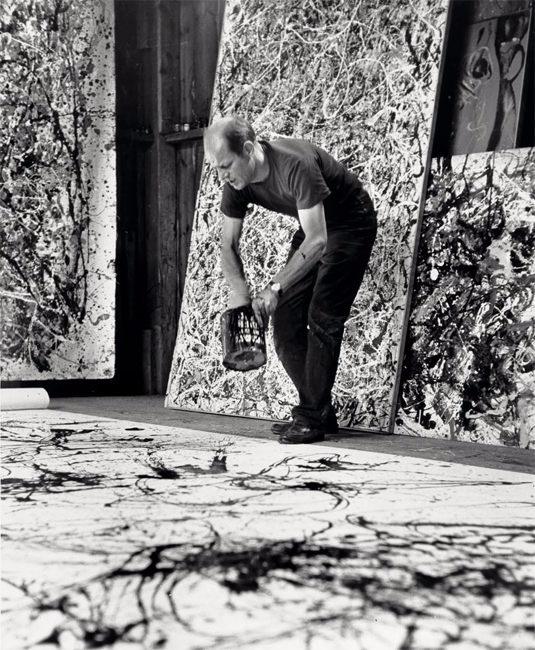s w i f t s & s l o w s: a quarterly of crisscrossings
Pollock’s Wristwatch, Doing Time
Sandy Kinnee & Jim Moore
←back or next→
Pollock’s Wristwatch
I have looked at many photographs of Jackson Pollock.
Few images show him wearing a wristwatch.
There is no clock on the wall of his studio.
Does he wear a wristwatch while he paints
because there is no wall clock
reminding him of dinner time?
Does Lee get mad if he is late for a meal?
He wears a black t-shirt, black jeans,
and a wristwatch only in the studio.
Why not a hat and a cape?
What time is it in Jackson’s studio?
Does he have an appointment with a bucket of black paint?
White paint and a stick or turkey baster?
Is his wristwatch another prop suggested
by the photographer?
Does it make him look more serious
to wear it strapped to his left wrist,
like a busy business man?
Is a watch on his arm shorthand for business suit and tie?
Perhaps it is a Rolex.
More likely a Timex.
If he were alive today he could certainly afford a Rolex.
Who wears a watch in the studio anyway?
 Jackson Pollock in his studio (1950), photograph by Hans Namuth
Jackson Pollock in his studio (1950), photograph by Hans Namuth
Doing Time
I at first misread a crucial place in this line: “Does he wear a wristwatch while he paints because there is no wall clock reminding him of dinner time?” I misread “dinner” as “doing” . It seems my unconscious was helping me out, as it sometimes does, letting me know that the real subject of the poem is time and the way awareness of time and its passing can be a spur to doing new work (after all, one has only so much time) but also time is something one wishes to get rid of, let go, lose track of entirely as one works.
There are a lot of questions, some rhetorical, some not. Questions in poems are like open doors, especially if the poem does not attempt to answer them. My favorite open door is the last line, which is possible to miss since it is buried under the photo of Pollock wearing that damn watch: “Who wears a wristwatch in the studio anyway?”
All artists are always doing time– either by trying to ignore it or feeling subservient to it (in this case subservience can actually be a useful thing) so really the question might just as well have been “Who doesn’t wear a wristwatch in the studio anyway”
Some of my favorite poems make room for contradictory ideas that, in the end, are complementary: Pollock’s Wristwatch” does just that by letting us see how time turns into timelessness and then back into time. Whether bound by it or freed from it, time is at the heart of the matter for writers and artists. We all “do time” in one way or another. It seems to me that, thanks to its humor, it is also saying let’s not get too invested in feeling we have to figure it all out (there are all those questions to keep us open-ended!). Let’s not forget to laugh in the midst of doing time. Anyone who has actually done time in prison, myself included, understands just how important it is to be able to laugh along the way.
←back or next→
Pollock’s Wristwatch: Sandy Kinnee. Doing Time: Jim Moore.
Sandy Kinnee, known in the 1970s for his work on shaped handmade paper, now splits his time between Colorado and Paris, painting and writing about painting. His upcoming book, PLASTER OF PARIS, is yet another example of his continuing self-indulgence. He paints on fifteen-foot sheets of unstretched canvas. The French refer to canvas unrestrained by frames or stretchers as: toile libré, which you might translate as an advertisement for free canvas. Canvas ain’t free until you liberate it.
sandykinnee.com →
Jim Moore has published seven books of poetry and an eighth will be published in 2021 or 2022 by Graywolf Press. His poems have appeared in American Poetry Review, Harpers, The Paris Review, The New Yorker, The Nation and others. He has received a Guggenheim Fellowship for his poetry. Jim lives in Minneapolis and is married to the photographer JoAnn Verburg. They recently created a collaboration for the German magazine Der Greif:
Para-Phrase: JoAnn Verburg / Jim Moore →
